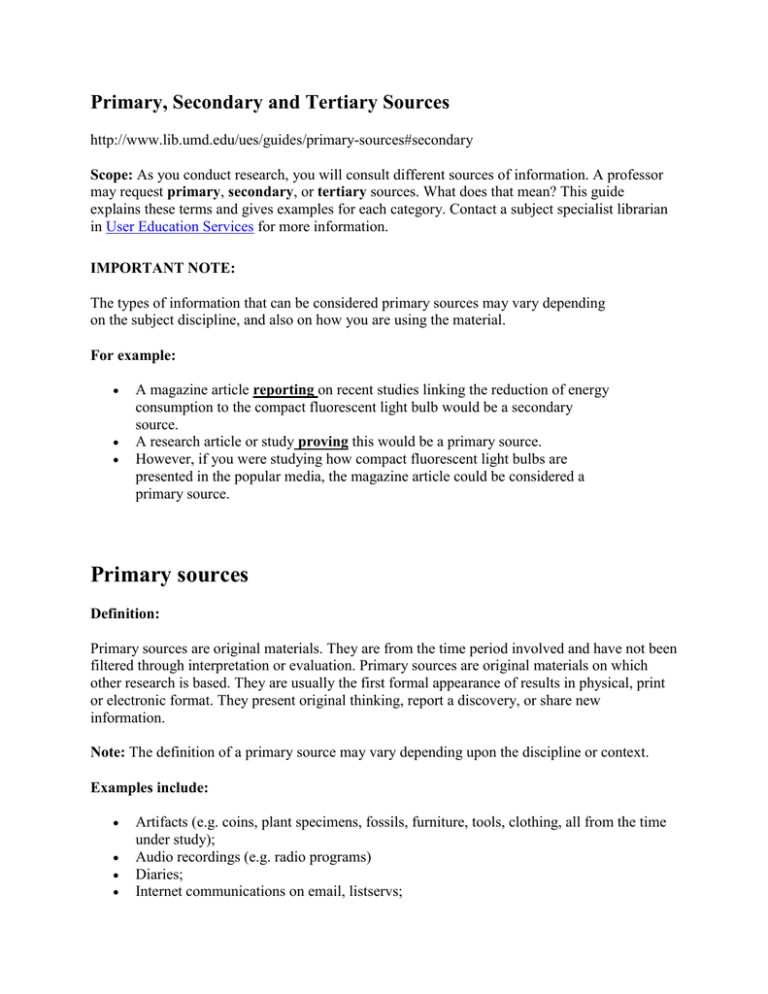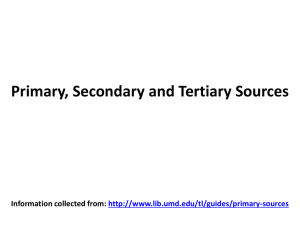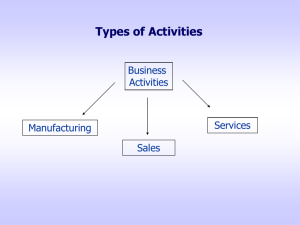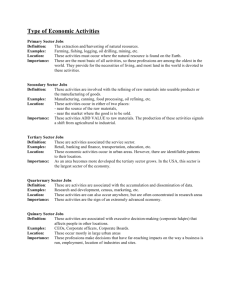Primary, Secondary and Tertiary Sources
advertisement

Primary, Secondary and Tertiary Sources http://www.lib.umd.edu/ues/guides/primary-sources#secondary Scope: As you conduct research, you will consult different sources of information. A professor may request primary, secondary, or tertiary sources. What does that mean? This guide explains these terms and gives examples for each category. Contact a subject specialist librarian in User Education Services for more information. IMPORTANT NOTE: The types of information that can be considered primary sources may vary depending on the subject discipline, and also on how you are using the material. For example: A magazine article reporting on recent studies linking the reduction of energy consumption to the compact fluorescent light bulb would be a secondary source. A research article or study proving this would be a primary source. However, if you were studying how compact fluorescent light bulbs are presented in the popular media, the magazine article could be considered a primary source. Primary sources Definition: Primary sources are original materials. They are from the time period involved and have not been filtered through interpretation or evaluation. Primary sources are original materials on which other research is based. They are usually the first formal appearance of results in physical, print or electronic format. They present original thinking, report a discovery, or share new information. Note: The definition of a primary source may vary depending upon the discipline or context. Examples include: Artifacts (e.g. coins, plant specimens, fossils, furniture, tools, clothing, all from the time under study); Audio recordings (e.g. radio programs) Diaries; Internet communications on email, listservs; Interviews (e.g., oral histories, telephone, e-mail); Journal articles published in peer-reviewed publications; Letters; Newspaper articles written at the time; Original Documents (i.e. birth certificate, will, marriage license, trial transcript); Patents; Photographs Proceedings of Meetings, conferences and symposia; Records of organizations, government agencies (e.g. annual report, treaty, constitution, government document); Speeches; Survey Research (e.g., market surveys, public opinion polls); Video recordings (e.g. television programs); Works of art, architecture, literature, and music (e.g., paintings, sculptures, musical scores, buildings, novels, poems). Web site. Secondary sources Definition: Secondary sources are less easily defined than primary sources. Generally, they are accounts written after the fact with the benefit of hindsight. They are interpretations and evaluations of primary sources. Secondary sources are not evidence, but rather commentary on and discussion of evidence. However, what some define as a secondary source, others define as a tertiary source. Context is everything. Note: The definition of a secondary source may vary depending upon the discipline or context. Examples include: Bibliographies (also considered tertiary); Biographical works; Commentaries, criticisms; Dictionaries, Encyclopedias (also considered tertiary); Histories; Journal articles (depending on the disciple can be primary); Magazine and newspaper articles (this distinction varies by discipline); Monographs, other than fiction and autobiography; Textbooks (also considered tertiary); Web site (also considered primary). Tertiary sources Definition: Tertiary sources consist of information which is a distillation and collection of primary and secondary sources. Almanacs; Bibliographies (also considered secondary); Chronologies; Dictionaries and Encyclopedias (also considered secondary); Directories; Fact books; Guidebooks; Indexes, abstracts, bibliographies used to locate primary and secondary sources; Manuals; Textbooks (also be secondary). Comparison across the disciplines SUBJECT PRIMARY SECONDARY TERTIARY Art and Architecture Painting by Manet Article critiquing art piece ArtStor database Chemistry/Life Sciences Einstein's diary Monograph on Einstein's life Dictionary on Theory of Relativity Engineering/Physical Sciences Patent NTIS database Manual on using invention Humanities Letters by Martin Luther King Web site on King's writings Encyclopedia on Civil Rights Movement Social Sciences Notes taken by clinical psychologist Magazine article about the Textbook on clinical psychological condition psychology Performing Arts Movie filmed in 1942 Biography of the director Guide to the movie



